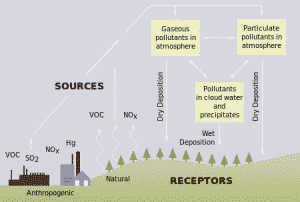Thermal flow meter development over the last couple of decades was largely driven to address the needs associated with environmental applications, including acid rain.
Continuous Emissions Monitoring (CEM) for Acid Rain
Thermal flow meters are a relatively new product, being introduced in the 1970s and 1980s. Like any new product, developments and advancements are usually dictated by the needs of the industry. Early in the product’s life, the need arose for continuous emissions monitoring (CEM) to address the acid rain problem.
Acid rain is an environmental issue that received much attention in the 1990s. It affects large portions of North America by harming lakes, streams, forests, and plant and animal life in these environments.

What is acid rain?
Acid rain refers to rain that has deposited material in it. It can be wet or dry material but has higher than normal levels of nitric and sulfuric acids—the causes of acid rain stem from natural and human-made sources. Natural precursors are volcanoes or decaying vegetation, while human-made sources include burning fossils fuels. Fossil fuel combustion creates emissions of sulfur dioxide (SO2) and nitrogen oxides (NOx). A significant amount of SO2 (~67%) and NOx (~25%) in the United States comes from power generation, particularly coal.
When SO2 and NOx react with oxygen, water, and other chemicals present in the atmosphere, sulfuric acid, and nitric acid are formed. These acidic compounds can be carried hundreds of miles from the precursor emissions sources by typical winds. When the air’s acidic chemicals are taken to areas where the weather is wet (wet deposition), the result is acidic rain, snow, or even fog. If the compounds travel to where the weather is dry (dry deposition), the chemicals incorporate into smoke or dust and stick to buildings, cars, the ground, or trees. Later the chemicals are washed away with rainfall, and the runoff becomes contaminated with the acids.
Consequences of Acid Rain
Acid rain (whether wet or dry deposition) causes the acidification of our lakes and streams, which damages trees and compromises our forest soils’ sensitive balance. It also quickens the decay of building materials, paints, sculptures, and statues. Additionally, acid rain derivatives, such as sulfates and nitrates, can be fine particles and, when inhaled, can cause heart and lung disease.
Thermal Flow Meter
To address the growing concerns of acid rain, in the 1990s, the EPA implemented the Acid Rain Program, which created a need for continuous emissions monitoring (CEM) and required the measurement of SO2 and NOx. By measuring the flow rate, as well as the concentration of SO2 and NOx, the acid rain precursor emissions can be measured. Thermal mass meters are ideal for this application and are among the three meters, aside from averaging Pitot tubes and ultrasonic flow meters, to successfully handle this application.
Perhaps you will find this video helpful.
Photo by Origins.gif: NHSavage at en.wikipedia derivative work: Zazou (Origins.gif) [Public domain], from Wikimedia Commons

